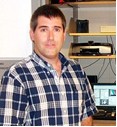Associate Professor
Department of Biological Sciences
University of Delaware
232 Wolf Hall
Newark, DE 19716
Email: dgalileo@udel.edu
Phone: (302) 831-1277
Fax: (302) 831-2767
Ph.D., Medical Sciences: Anatomical Sciences, Department of Anatomy and Cell Biology, University of Florida College of Medicine, Gainesville, FL and Whitney Laboratory, Saint Augustine, FL, 1988
B.A. in Biology: Cell/Developmental Biology, New College of Florida, Sarasota, FL, 1983

A main technology we use is one that I helped to develop since the 1980’s: retroviral gene transfer. Here, a recombinant retroviral vector carrying a marker gene and another cDNA (or its antisense copy) can be usedin vivo to infect brain progenitor cells that line the ventricular cavity. The retroviral vector will incorporate the recombinant DNA into the infected cell’s genome and express it. Then, we can analyze how the expressed single protein (or the antisense-attenuated endogenous protein) affects the processes we are interested in. A focal point of the lab now is to further develop and utilize the chick embryo as a model for the study and manipulation of basic mechanisms of abnormal brain cell migration- i.e. glioma tumor cell local invasiveness and breast cancer spread to brain. This is a logical extension of our v-src, integrin, and NgCAM/L1 work, and is of interest because the insidious nature of glioma cells lies in their capacity to extensively migrate throughout the brain, particularly along axon tracts and blood vessels. This extensive migration usually precludes successful resection of the tumor by surgery. I believe that some of the same molecules and mechanisms that are used during normal neuronal migration are usurped by glioma and other cancer cell types that spread in the brain and elsewhere.
Toward this new focus on cancer, we have shown that human and rat glioma tumor cell lines are capable of producing invasive tumors in the developing chick brain and are now performing experiments to determine if primary human glioma tumor cells from surgical samples do this as well (in collaboration with the Helen F. Graham Cancer Center). We also have shown that human breast cancer cells injected into the extraembryonic blood vessels of the chick embryo extravasate and invade the brain and other organs within days. Retroviral vectors are also being used to stably mark tumor cells as well as to alter expression of specific tumor cell proteins. This novel chick model ultimately should be as useful as immunodeficient mice for studying certain mechanisms of invasive brain tumors, and it has several practical advantages like accessibility, ease of manipulation, and cost. Brain metastases from breast cancer often kill within weeks to months, and this new model undoubtedly will prove useful in studying certain aspects of metastasis, like homing to brain and extravasation. Lastly, we have developed a sophisticated time-lapse microscopy system and have used it to study mechanisms of tumor cell migration in vitro. Thus, our in vivo chick system and in vitro microscopy system provide complementary approaches to studying several important aspects of tumor cell biology.